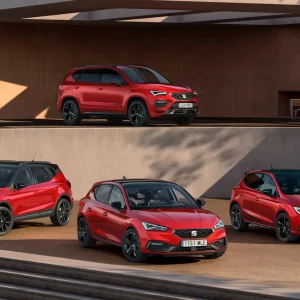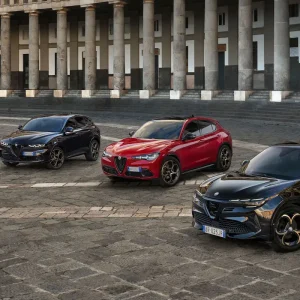The LBX is key to Lexus’ growth in the UK this year, we have been told, but we first set eyes on the model (the name said to stand for Lexus Breakthrough Crossover) over a year ago. First thoughts of this then unnamed model were that it looked sharp and could be an interesting premium addition to the consistently growing B-SUV sector.
Outside, it still looks sharp, cleverly integrating key Lexus styling cues into a smaller package with a more youthful feel to appeal to younger buyers. At the front, there’s the same large front grille, but for the LBX, it’s frameless, with the metal highlights reserved for the flash between the arced light units and the bottom of the front air dam. At the side, there’s some neat metal detailing around the arches and rear haunches – with the curvy roofline finishing the look. At the back, the LBX again stands out, with the high-set rear lights stretching across to form a light bar, a low-mounted numberplate which we were told gives more prominence, and the distinctive rear spoiler.
Inside our mid-range Premium test car, the size might be smaller, but the feel is Lexus. This is best demonstrated by the horizontal dashboard, that gives the illusion of greater width. The driver’s area itself is Lexus’s latest interpretation of its ‘Tazuna concept,’ where key controls are put immediately around the driver. On top of the 12.3in driver’s display, the centre console is dominated by the moderately sized and easy-to-use 9.8in touchscreen.
Space in the front of the LBX and the driving position is fine – even for the tallest drivers. The back of the baby Lexus is more compromised – fine for young, empty-nester professionals, less good for those with children. Still, the 402-litre boot is practically shaped, even if there are no clever features such as a false floor.
Underneath the LBX’s new styling, this Lexus has more to do with the Toyota Yaris Cross, as they share the same GA-B small car platform. However, the Lexus is lengthened by 20mm and has a bigger hybrid battery, equalling 134hp.
The B-SUV sector might be going electric, with key rivals including the excellent Volvo EX30, but the LBX is only available with an electrified powertrain in 1.5-litre hybrid form. There will also be an all-wheel drive (AWD) range-topping version, with another electric motor on the rear axle. The three-cylinder, 1.5-litre, develops 120Nm of torque, and a 0-62mph acceleration time of 9.2 seconds, although front-wheel drive (FWD) versions are expected to be the key sellers for fleet. It is impressively frugal; we saw high 50s mpg on the test route. Go for the AWD LBX, and it’s slightly slower to 60mph, at 9.6 seconds.
Mated with the latest evolution of Lexus’s e-CVT transmission, the electric motor works best at low speed around town, adding welcome extra torque to its slick and refined nature. The LBX is less fun when asked to work harder, or when its battery is depleted, then its impressive refinement is spoilt by the sound of a three-cylinder engine getting thrashier and noisier. The LBX’s ride on the 19in wheels fitted to our Premium trim test car was generally compliant and comfortable – although it did feel unsettled in places out of town. The LBX driving experience is best described as well-ordered, but nothing more. When you need to stop, the brakes have plenty of feel. This, along with the handling, benefit from its braking posture control system, which works by reducing the pitching when slowing down and reducing body roll in corners. It works well and is not intrusive.
Specs are decent, but there’s a confusing choice of Urban, Premium (expected to be the most popular fleet choice), Premium Plus and Takumi. On top of these, there are Design Grades, with what Lexus describe as ‘more expressive interior and exterior design execution’. Prices start at £29,995 for the entry-level Urban spec, which although cheap for a Lexus is punchy compared with rivals.
Lexus LBX 1.5 Premium
P11D: £32,265
Residual value: 47.8%
Depreciation: £15,989
Fuel: N/A
Service, maintenance and repair: £2,195
Cost per mile: N/A
Fuel consumption: N/A
CO2 (BIK %): 105g/km (26%)
BIK 20/40% a month: £140/£280
Luggage capacity: 402 litres
Engine size/power: 1,490cc/134hp





